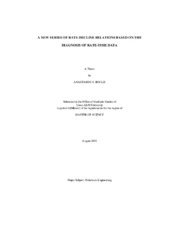| dc.description.abstract | The so-called "Arps" rate decline relations are by far the most widely used tool for assessing oil and gas reserves from rate performance. These relations (i.e., the exponential and hyperbolic decline relations) are empirical where the starting point for their derivation is given by the definitions of the "loss ratio" and the "derivative of the loss ratio", where the "loss ratio" is the ratio of rate data to derivative of rate data, and the "derivative of the loss ratio" is the "b-parameter" as defined by Arps [1945].
The primary goal of this work is the interpretation of the b-parameter continuously over time and thus the better understanding of its character. As is shown below we propose "monotonically decreasing functional forms" for the characterization of the b-parameter, in addition to the exponential and hyperbolic rate decline relations, where the b-parameter is assumed to be zero and constant, respectively. The proposed equations are as follow: b(t)=constant (Arps' hyperbolic rate-decline relation), []tbbtb10exp)(-bt= (exponential function), (power-law function), 10)(btbtb=)/(1)(10tbbtb+= (rational function).
The corresponding rate decline relation for each case is obtained by solving the differential equation associated with the selected functional for the b-parameter. The next step of this procedure is to test and validate each of the rate decline relations by applying them to various numerical simulation cases (for gas), as well as for field data cases obtained from tight/shale gas reservoirs.
Our results indicate that b-parameter is never constant but it changes continuously with time. The ultimate objective of this work is to establish each model as a potential analysis/diagnostic relation. Most of the proposed models yield more realistic estimations of gas reserves in comparison to the traditional Arps' rate decline relations (i.e., the hyperbolic decline) where the reserves estimates are inconsistent and over-estimated. As an example, the rational b-parameter model seems to be the most accurate model in terms of representing the character of rate data; and therefore, should yield more realistic reserves estimates. Illustrative examples are provided for better understanding of each b-parameter rate decline model.
The proposed family of rate decline relations was based on the character of the b-parameter computed from the rate-time data and they can be applied to a wide range of data sets, as dictated by the character of rate data. | en |


